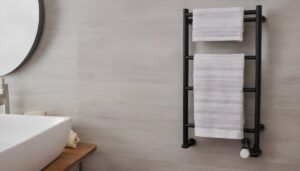Are Towel Warmers Safe? Debunking Myths and Ensuring Safety
With their luxurious and cozy touch, towel warmers have become a modern bathroom must. There are still concerns regarding their safety despite their widespread use. Towel warmers are, nevertheless, typically safe gadgets when operated properly. A prevalent apprehension is the potential for fire, especially in electric ones. Purchasing high-quality towel warmers and making sure they are installed correctly are crucial steps in reducing this risk. Furthermore, routine temperature monitoring and maintenance can improve safety even more. The energy consumption of towel warmers is another fallacy. Many contemporary models are energy-efficient and need very little electricity, despite popular opinion. All things considered, towel warmers can offer a comfortable and hygienic experience in the bathroom, but it’s important to be aware of safety risks.
I. Introduction
The capacity of towel warmers, sometimes referred to as heated towel racks or rails, to improve the bathing experience has led to their increasing popularity. After taking a shower or bath, these gadgets are meant to warm bathrobes and towels, giving an opulent and cozy feeling. Towel warmers are already a typical fixture in contemporary bathrooms, providing both functional and decorative advantages. Daily routines are elevated to a new level of enjoyment by the attraction of stepping out of the shower into a warm towel. Towel warmer safety is a common concern despite their widespread use. This post will dispel common misconceptions about towel warmers, discuss safety issues related to them, and offer advice on how to use them safely.
II. How Do Towel Warmers Work?
Depending on the model, towel warmers can run on electricity or hot water. When powered on, internal heating components in electric towel warmers warm up. These components provide heat to the towel warmer’s metal bars or coils, which in turn heats the towels that are draped over them. Conversely, hydronic towel warmers are linked to the hot water system of a residence, which could be a boiler or radiator. Warm towels are produced by heating the bars or coils via the flow of hot water through pipes inside the towel warmer. The excellent distribution of heat in both electric and hydronic towel warmers guarantees that towels are warmed uniformly. Towel warmers offer an easy-to-use solution for enjoying warm towels after taking a bath; its function is straightforward overall.
III. The Safety Features of Modern Towel Warmers
Safety elements are incorporated into contemporary towel warmers to reduce potential risks and guarantee user safety. Typically, these characteristics include automated shut-off devices to reduce the risk of overheating and fire. Furthermore, a lot of models have integrated temperature controls that let customers customize the heat level to suit their tastes. These controls lessen the chance of burns and keep towels from getting excessively hot. Moreover, premium building supplies are employed to improve security and longevity; stainless steel is a common material due to its ability to withstand heat and corrosion. To provide consumers have piece of mind, certain towel warmers also go through extensive testing to fulfill safety requirements and certifications.

IV. Potential Risks and How to Mitigate Them
For safe use, it is imperative to comprehend any potential concerns related to towel warmers. Mostly, the danger of fire is a major worry, especially for electric vehicles. Towel warmers with integrated safety features, such automated shut-off mechanisms, are essential if you want to reduce this risk. Furthermore, to guarantee that electrical components are securely fastened and properly wired, competent installation by trained experts is essential. Overheating is an additional concern that needs to be taken into account as it can cause burns or tear towels. By routinely checking the temperature settings and limiting their time spent near warm surfaces, users can lessen this danger.
V. Industry Standards and Certifications
The safety and quality of towel warmers are greatly enhanced by industry standards and certifications. A lot of manufacturers follow requirements that have been laid forth by agencies like the International Electrotechnical Commission (IEC) or Underwriters Laboratories (UL). To ensure that products fulfill safety standards, these standards specify how they must be designed, built, and tested. Ensuring the durability, electrical safety, and heat distribution capabilities of towel warmers that meet these standards is done through extensive testing. Further proof that the product satisfies particular safety standards required by regulatory bodies comes via certifications like the CE mark in Europe and the ETL mark in North America. Customers may trust in the dependability and safety of the product by selecting towel warmers that have earned industry certifications.
VI. Real User Experiences
Real-world user experiences offer insightful information about the usefulness of towel warmers. Towel warmers are praised by many users for their comfort and convenience, calling them a useful addition to restrooms. Good experiences frequently emphasize how quickly towel warmers heat up, enabling customers to enjoy warm towels just moments after turning them on. Towel warmers are multipurpose devices that can be used not just for drying wet towels but also for warming blankets and drying damp clothes, as several users have noted. It’s important to take into account a range of user experiences, though, as some customers can have problems like inconsistent heating or durability issues. Prospective customers can choose the towel warmer that best fits their needs and tastes by reading actual user reviews.
VII. Tips for Safe Use
1.To ensure correct positioning and secure mounting, install the towel warmer in accordance with local building requirements and manufacturer instructions.
2.Check the towel warmer on a regular basis for indications of wear, damage, or loose connections. Take quick action to fix any problems you find.
3.Towels and other objects should not be piled too high within the towel warmer as this may obstruct adequate airflow and heating.
4.Handle warm towels carefully to avoid burns, especially on small children or skin-sensitive people.
5.Keep an eye on the towel warmer’s temperature settings and steer clear of overheating, which could make the towels uncomfortable to handle or possibly start a fire.
6.To reduce the possibility of a fire, keep combustible items far from the towel warmer, such as clothing or drapes.
VIII. Towel Warmer Alternatives
There are other options for people looking for warmth and comfort after taking a bath, even if towel warmers are unquestionably luxurious and convenient. Using a heated towel rack is one popular substitute; it functions similarly to a towel warmer but is frequently more portable and small. Although they might not be as practical or effective, electric heated throws or blankets can also be used to cover towels to provide warmth. Warming towels with a conventional radiator or heating vent is an additional choice, albeit it might not be as efficient or designed with towel heating in mind. Some people also choose heated towel rails or bars that are part of their bathroom’s heating system, which eliminates the need for an additional appliance and provides warmth.
IX. Addressing Common Misconceptions
In order to give customers correct information, it is imperative that frequent misconceptions regarding towel warmers be addressed. A common misconception is that towel warmers use an inordinate amount of electricity. In contrast to traditional heating appliances, many contemporary versions are made to be energy-efficient and use very little power. Towel warmers are not just for opulent bathrooms, as is another common misperception. Towel warmers actually available in a range of sizes and designs to suit a variety of settings and price points. Furthermore, a few people think that towel warmers could catch fire. The risk of fire can be increased by misuse or faulty installation, but it can be greatly reduced by adhering to safety regulations and selecting high-quality equipment. Customers may make knowledgeable judgments regarding installing towel warmers in their homes by dispelling these myths and offering accurate information.
X. How Towel Warmers Enhance Bathroom Safety
Bathroom safety can be improved in a number of ways using towel warmers, in addition to offering warmth and comfort. They can help prevent the spread of mold and mildew and improve air quality by lowering the moisture and humidity levels in the bathroom, which is one important feature. Warm towels also dry faster after being wet, which lowers the possibility of mishaps and the danger of slipping. Additionally, especially in the winter, the warmth that towel warmers give can assist keep the restroom at a pleasant temperature and lessen the risk of injury from the cold. Towel warmers may also serve as a backup source of heat in restrooms, enhancing the comfort of the space and working in tandem with pre-existing HVAC systems.
XI. Towel Warmers in Different Settings
In addition to standard restrooms, towel warmers are multipurpose gadgets. Towel warmers are a necessary part of a pleasant experience that helps customers relax during massages or other spa treatments at spas and health centers. Warm towels are often provided as a welcome amenity or after swimming in pool areas by hotels and resorts in an effort to improve the visitor experience. Further uses for towel warmers include at gyms and fitness centers, where they give patrons warm towels to wrap up with after strenuous workouts or showers. Also, to effectively dry damp towels, clothing, or outerwear, towel warmers can be put in laundry rooms or mudrooms.
XII. Conclusion
To sum up, towel warmers have several advantages, from improving restroom safety and hygiene to offering warmth and relaxation. Contrary to popular belief, contemporary towel warmers are built with safety safeguards to reduce concerns like overheating and fire threats. Through adherence to appropriate installation protocols and upkeep standards, consumers can relish the comfort of heated towels without sacrificing security. Towel warmers are also multipurpose gadgets that can be utilized in spas, hotels, gyms, and laundry facilities in addition to bathrooms. Their capacity to foster desiccation, warmth, and coziness renders them indispensable components for any area. Towel warmers provide practical functions by improving convenience and hygiene while also making the user’s experience more pleasant and joyful overall.


Amazing
[…] it comes to elevating your bathing experience, a towel warmer can be a game-changer. These devices not only add a touch of luxury to your space but also provide […]
Well done
thanks
[…] advantages of towel warmers extend beyond the comfort of a warm towel. They play a role in maintaining hygiene, drying towels faster, and even reducing laundry loads. […]
Nice
Excellent 👌
Good 👍
best article
I like the article
Lovely 😍
So beautiful 😍
So nice
[…] Towel warmers, once considered a lavish addition to upscale bathrooms, are now making their way into mainstream households. Beyond the primary function of warming towels, these fixtures bring a touch of luxury and sophistication to your bathroom. Available in various types, including electric and hydronic models, they offer versatility in installation and energy efficiency. […]
Good
Good
[…] towel warmers and towel steamers excel in providing rapid heating. However, the method differs. Towel warmers […]
[…] the combination of a towel warmer and UV sterilizer is indispensable. Clients not only enjoy the comfort of warm towels but also appreciate the commitment to maintaining a clean and sanitized […]
[…] the warm embrace of a perfectly heated towel. This article explores the nuances of the Brookstone Towel Warmer, shedding light on its features, benefits, and why it has become a staple in modern […]
Wow